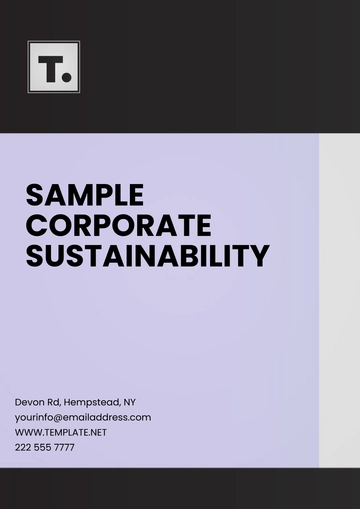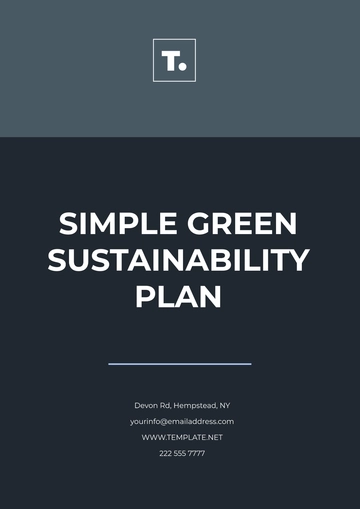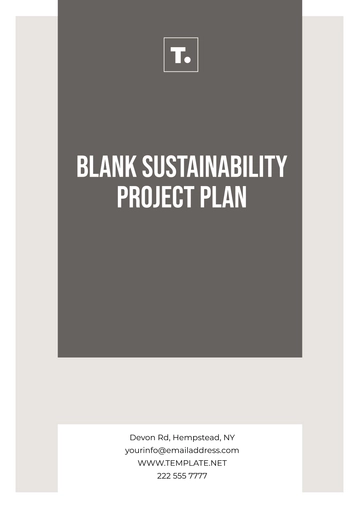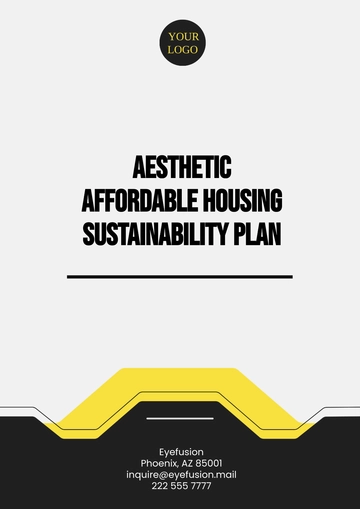Free Green Building Sustainability Plan Design

Green Building Sustainability Plan Design
Date: [Date]
Prepared By: [Your Name]
I. Executive Summary
This Green Building Sustainability Plan aims to incorporate sustainable practices into the design, construction, and operation of the building. It outlines the strategies to minimize environmental impact, maximize energy efficiency, and create a healthy, productive environment for occupants. The focus is on reducing energy consumption, water usage, waste, and carbon emissions, while optimizing indoor environmental quality.
II. Purpose
The purpose of this plan is to:
Reduce the building's ecological footprint.
Integrate sustainable materials and energy-efficient technologies.
Provide a comfortable and healthy indoor environment.
Achieve environmental certifications such as LEED (Leadership in Energy and Environmental Design).
III. Scope
This plan applies to all phases of the building project, including:
Design and Planning
Construction
Operations and Maintenance
Post-Occupancy Monitoring
IV. Sustainability Criteria
The following criteria will guide the sustainability efforts:
1. Energy Efficiency
Use of energy-efficient HVAC systems.
Installation of solar panels and renewable energy sources.
High-performance insulation and energy-efficient windows to reduce heating and cooling needs.
Implementation of smart building technologies to monitor and control energy usage.
2. Water Conservation
Installation of low-flow fixtures in bathrooms and kitchens.
Rainwater harvesting systems for irrigation and non-potable uses.
Landscaping with drought-resistant plants to minimize water use.
Greywater recycling systems.
3. Sustainable Materials
Use of locally sourced, recycled, and low-impact materials.
Prioritization of non-toxic and low-VOC (volatile organic compound) finishes.
Sustainable flooring options, such as bamboo, cork, or reclaimed wood.
4. Indoor Environmental Quality
Use of natural lighting and ventilation to improve air quality and reduce reliance on artificial lighting.
Incorporation of plants for improved indoor air quality and aesthetic appeal.
Low-emission paints and finishes to minimize indoor pollutants.
Advanced air filtration systems to maintain high air quality.
5. Waste Reduction
Implement a construction waste management plan to recycle or reuse materials during the construction phase.
Encourage a zero-waste approach by providing recycling and composting facilities within the building.
Promote paperless operations and electronic waste recycling.
6. Carbon Footprint Reduction
Incorporate carbon offset programs to neutralize emissions.
Use of electric or hybrid vehicles for the transportation of materials and staff.
Promote the use of public transportation, carpooling, and cycling by providing bike racks and electric vehicle charging stations.
V. Evaluation and Monitoring
Continuous evaluation will be essential to ensure the sustainability goals are met:
Use energy and water consumption data to identify areas for improvement.
Conduct regular audits of waste management practices.
Monitor indoor air quality and occupant feedback for ongoing improvements.
Utilize building management systems (BMS) to track performance metrics.
VI. Timeline
Design and Planning Phase: 3-6 months
Construction Phase: 12-18 months
Operation and Maintenance: Ongoing
Post-Occupancy Evaluation: 6 months after occupancy
VII. Budget Allocation
Investing in green building technologies may incur higher initial costs but will result in long-term savings and environmental benefits:
Energy Efficiency Measures: 30%
Water Conservation Systems: 20%
Sustainable Materials: 25%
Indoor Environmental Quality Improvements: 15%
Waste Management and Carbon Reduction Programs: 10%
VIII. Conclusion
By adhering to the Green Building Sustainability Plan, we will create a more sustainable, energy-efficient, and healthy building environment. This initiative supports not only environmental goals but also the well-being of building occupants, ensuring a positive impact on both the planet and its people.
- 100% Customizable, free editor
- Access 1 Million+ Templates, photo’s & graphics
- Download or share as a template
- Click and replace photos, graphics, text, backgrounds
- Resize, crop, AI write & more
- Access advanced editor
The Green Building Sustainability Plan Design Template, offered by Template.net, is a comprehensive and customizable solution for creating eco-friendly building designs. This downloadable and printable template helps you plan and implement sustainable practices effectively. Easily editable in our AI Editor Tool, it allows you to tailor the design to your specific needs, ensuring your green building projects meet environmental goals with ease.
You may also like
- Finance Plan
- Construction Plan
- Sales Plan
- Development Plan
- Career Plan
- Budget Plan
- HR Plan
- Education Plan
- Transition Plan
- Work Plan
- Training Plan
- Communication Plan
- Operation Plan
- Health And Safety Plan
- Strategy Plan
- Professional Development Plan
- Advertising Plan
- Risk Management Plan
- Restaurant Plan
- School Plan
- Nursing Home Patient Care Plan
- Nursing Care Plan
- Plan Event
- Startup Plan
- Social Media Plan
- Staffing Plan
- Annual Plan
- Content Plan
- Payment Plan
- Implementation Plan
- Hotel Plan
- Workout Plan
- Accounting Plan
- Campaign Plan
- Essay Plan
- 30 60 90 Day Plan
- Research Plan
- Recruitment Plan
- 90 Day Plan
- Quarterly Plan
- Emergency Plan
- 5 Year Plan
- Gym Plan
- Personal Plan
- IT and Software Plan
- Treatment Plan
- Real Estate Plan
- Law Firm Plan
- Healthcare Plan
- Improvement Plan
- Media Plan
- 5 Year Business Plan
- Learning Plan
- Marketing Campaign Plan
- Travel Agency Plan
- Cleaning Services Plan
- Interior Design Plan
- Performance Plan
- PR Plan
- Birth Plan
- Life Plan
- SEO Plan
- Disaster Recovery Plan
- Continuity Plan
- Launch Plan
- Legal Plan
- Behavior Plan
- Performance Improvement Plan
- Salon Plan
- Security Plan
- Security Management Plan
- Employee Development Plan
- Quality Plan
- Service Improvement Plan
- Growth Plan
- Incident Response Plan
- Basketball Plan
- Emergency Action Plan
- Product Launch Plan
- Spa Plan
- Employee Training Plan
- Data Analysis Plan
- Employee Action Plan
- Territory Plan
- Audit Plan
- Classroom Plan
- Activity Plan
- Parenting Plan
- Care Plan
- Project Execution Plan
- Exercise Plan
- Internship Plan
- Software Development Plan
- Continuous Improvement Plan
- Leave Plan
- 90 Day Sales Plan
- Advertising Agency Plan
- Employee Transition Plan
- Smart Action Plan
- Workplace Safety Plan
- Behavior Change Plan
- Contingency Plan
- Continuity of Operations Plan
- Health Plan
- Quality Control Plan
- Self Plan
- Sports Development Plan
- Change Management Plan
- Ecommerce Plan
- Personal Financial Plan
- Process Improvement Plan
- 30-60-90 Day Sales Plan
- Crisis Management Plan
- Engagement Plan
- Execution Plan
- Pandemic Plan
- Quality Assurance Plan
- Service Continuity Plan
- Agile Project Plan
- Fundraising Plan
- Job Transition Plan
- Asset Maintenance Plan
- Maintenance Plan
- Software Test Plan
- Staff Training and Development Plan
- 3 Year Plan
- Brand Activation Plan
- Release Plan
- Resource Plan
- Risk Mitigation Plan
- Teacher Plan
- 30 60 90 Day Plan for New Manager
- Food Safety Plan
- Food Truck Plan
- Hiring Plan
- Quality Management Plan
- Wellness Plan
- Behavior Intervention Plan
- Bonus Plan
- Investment Plan
- Maternity Leave Plan
- Pandemic Response Plan
- Succession Planning
- Coaching Plan
- Configuration Management Plan
- Remote Work Plan
- Self Care Plan
- Teaching Plan
- 100-Day Plan
- HACCP Plan
- Student Plan
- Sustainability Plan
- 30 60 90 Day Plan for Interview
- Access Plan
- Site Specific Safety Plan





























